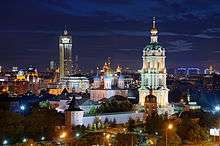Novospassky Monastery
Coordinates: 55°43′55″N 37°39′24″E / 55.73194°N 37.65667°E


Novospassky Monastery (New monastery of the Saviour, Russian: Новоспасский монастырь) is one of the fortified monasteries surrounding Moscow from south-east.
It was the first monastery to be founded in Moscow in the early 14th century. The Saviour Church was its original katholikon. Upon its removal to the left bank of the Moskva River in 1491, the abbey was renamed the New Saviour, to distinguish it from the older one in the Kremlin.[1]
The monastery was patronized by Andrei Kobyla's descendants, including the Sheremetyev and Romanov boyars, and served as their burial vault. Among the last Romanovs buried in the monastery were Xenia Shestova (the mother of the first Romanov Tsar), Princess Tarakanova (a pretender who claimed to have been the only daughter of Empress Elisabeth) and Grand Duke Sergei Alexandrovich of Russia. In 1571 and 1591, the wooden citadel withstood repeated attacks of Crimean Tatars.[2]
Upon the Romanovs' ascension to the Moscovy throne, Michael of Russia completely rebuilt their family shrine in the 1640s. Apart from the huge 18th-century bell-tower (one of the tallest in Moscow) and the Sheremetev sepulchre in the church of the Sign, all other buildings date from that period. They include:
- The Cathedral of the Transfiguration (Russian: Преображенский собор) (1645-49), a large five-domed katholikon with frescoes by the finest Muscovite painters of the 17th century[2][3]
- The Intercession Church[3] (Russian: Преображенский собор) or Church of the Veil of the Virgin[1] (1673-1675) with a refectory
- The Church of the Sign[1] or Church of the Znamenie Icon of the Virgin[2] (1791-1795)
- The bell tower (1759-1785)[2]
- The infirmary Church of St. Nicholas the Miracle Worker[1] and monks' living quarters
- The house of Patriarch Filaret[1]
- The House of Loaf-Giving.
During the Soviet years, the monastery was converted into a prison, then into a police drunk tank. In the 1970s it was assigned to an art restoration institute, and finally returned to the Russian Orthodox church in 1991.
References
- 1 2 3 4 5 "The Novospassky Monastery". moscow.info. Retrieved 20 February 2015.
- 1 2 3 4 Brumfield, William (20 June 2014). "Novospassky Monastery: Romanov shrine". Russia Beyond The Headlines. Rossiyskaya Gazeta. Retrieved 20 February 2015.
- 1 2 "Novospassky Monastery". lonelyplanet.com. Retrieved 20 February 2015.
External links
 Media related to Novospassky Monastery at Wikimedia Commons
Media related to Novospassky Monastery at Wikimedia Commons- Official Page of the Monastery, in Russian